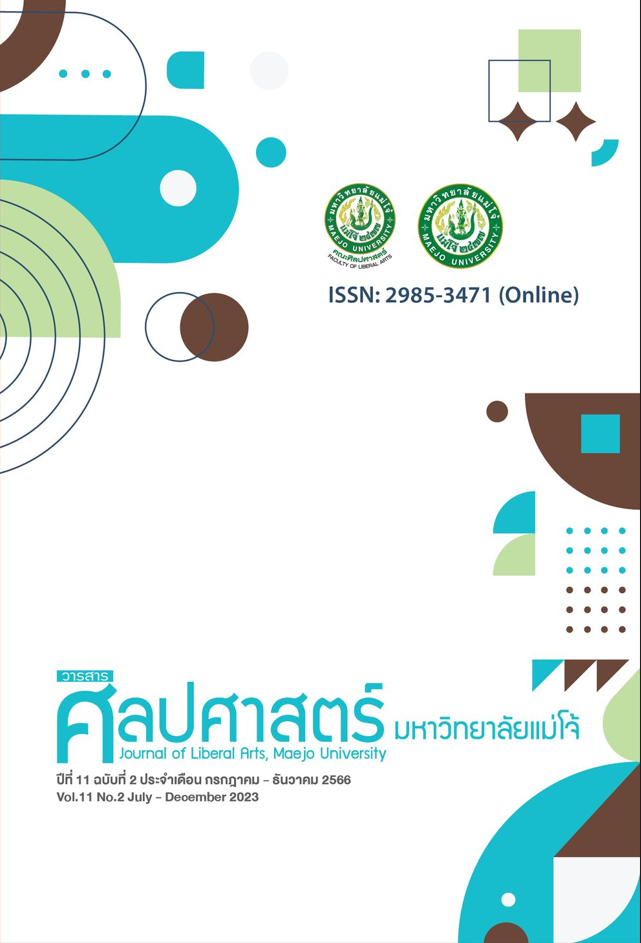การตีความด้านวากยสัมพันธ์ของคำนามที่ถูกยกระดับในโครงสร้างที่ประธานเป็นผู้ถูกกระทำผ่านการเรียบเรียงข้อมูลเก่า: มุมมองจากนวนิยายภาษาอังกฤษและบทความวิจัยภาษาศาสตร์ประยุกต์
Main Article Content
บทคัดย่อ
This study examines syntactic interpretations of the raised DP in passive voice via the principle of pragmatic discourse of givenness in English novels and journals of English applied linguistics. Regarding the source of data, a total number of approximately 600,000 words which are equally divided into approximately 300,000 words for each dataset. 10 English novels and 30 research articles of journal of English applied linguistics were collected to study. These novels were selected on the criteria of the best-sellers via the website of amazon.com. Journals of English applied linguistics as indexed in the SCOPUS database are PASSA Journal, LEARN Journal and rEFLections, which contains 10 research papers for each journal. The total number of passive voice in both datasets was 55 tokens, which are made up of 21 tokens in English novels and 34 tokens in journals of English applied linguistics. The syntactic interpretations of the raised DP in passive voice follows Radford’s (2009) generative grammar. The results in English novels show that the highest percentage of the raised DP in passive voice are due to the syntactic interpretations of replacement by pronouns at 57.14 precent. This phenomenon is explained by horror aequi principle. On the other hand, the highest percentage of the raised DP in passive voice in journals of English applied linguistic is the same DP at 64.70 percent. This phenomenon is explained by the academic norm of consistency in writing research papers. It is expected that this study will be beneficial for learners of English as a Foreign Language (EFL) in order to apply the raised DP in passive voice in English novels and journals of English applied linguistics accurately and appropriately.
Article Details

อนุญาตภายใต้เงื่อนไข Creative Commons Attribution-NonCommercial-NoDerivatives 4.0 International License.
ต้นฉบับที่ได้รับการตีพิมพ์ในวารสารคณะศิลปศาสตร์ มหาวิทยาลัยแม่โจ้ ถือเป็นกรรมสิทธิ์ของมหาวิทยาลัยแม่โจ้ ห้ามนำข้อความทั้งหมดหรือบางส่วนไปพิมพ์ซ้ำ เว้นเสียแต่จะได้รับอนุญาตจากมหาวิทยาลัยฯ เป็นลายลักษณ์อักษรเอกสารอ้างอิง
Alcott, L. M. (2009). Little Woman. New York: Penguin Random House.
Basturkmen, H. (2010). Developing Courses in English for Specific Purposes. Hampshire: Palgrave Macmillan.
Batubara, M. H., & Mahardhika, M. G. S. (2020). An analysis on students; difficulty in changing active to passive voice. Jurnal As-Salam, 4(1), 61-78.
Burroughs, W. S. (2016). Naked Lunch. New York: Penguin Random House.
Capote, T (2022). Breakfast at Tiffany’s. New York: Penguin Random House.
Chinpakdee, M. (2022). Understanding teacher autonomy through teachers’ online experiences. rEFLections, 29(3), 586-602.
Fitzgerald, F. S. (2021). The Great Gatsby: A Novel. New York: Black Dog & Leventhal Publishers.
Fowler, R. (2013). Linguistics and Novel. London: Routledge.
Halliday, M. A. K., & Hasan, R. (1976). Cohesion in English. London: Routledge.
He, Y. (2023). Non-canonical world order and its discourse functions in English Fairy Tales. Lecture Notes in Language and Linguistics, 6(6), 14-17
Hussien, A. S. (2014). Factors affect search engine optimization. International Journal of Computer Science and Network Security, 14(9), 28-33.
Jackson, S. (2022). The Lottery. New York: Penguin Random House.
James, H. (2021). The Turn of the Screw. New York: Penguin Random House.
Kerouac, J. (2022). On the Road. New York: Penguin Random House.
Kulprasit, W. (2022). Formative multimodal E-feedback in second Language writing virtual learning spaces. PASAA Journal, 64, 52-67.
McEnery, T. & Xiao, R. (2005). Passive constructions in English and Chinese: a corpus-based contrastive study. Language in Contrast, 6(1), 109-149.
Minton, T. D. (2015). In defense of the passive voice in medical writing. The Keio Journal of Medicine, 64(1), 1-10.
Nipaspong, P. (2022). The effects of online corrective feedback on university students’ self-regulation in writing. PASAA Journal, 64, 23-51.
O’neill, D. (2005). Talking about new information: the given/new distinction and children developing theory. Janet Wilde Astington & Jodie A. Baird. In Why language matter for theory of mind (pp. 84-100). Oxford: Oxford University Press.
Paquot, M. (2007). Towards a productively-oriented academic word list. Walinski, J., Kredens, K., Gozdz Roszkowski, S., (eds.). In Practical Applications in Language and Computers (pp. 127-140). Frankfurt: Peter Lang
Radford, A. (2009). An introduction to English sentence structures. Cambridge: Cambridge University Press.
Radford, A. (2020). Analysing English sentence structure: An intermediate course in syntax. Cambridge: Cambridge University Press.
Restituyo, M. R. (2022). English phonology: A manual to English Phonology. Florida: Xulon.
Rossiter, A. (2022). A descriptive grammar of English: Modern English grammar by example. Tennessee: Lingua.
Rudanko, J., Archer, D., Rayson, P., Wilson, A., & McEnery, T. (2003). More on horror aequi: Evidence from large corpora. Archer Corpus Linguistics, 17(1), 662-668.
Seo, Y. & Kim, C. (2020). The use of short fictions in a writing class: Pedagogical suggestion for Secondary level teachers in EFL setting. English Teaching, 75(1), 119-139.
Shabani, K. (2016). Applications of Vygotsky’s sociocultural approach for teachers’ professional development. Cogent Education, 3(1), 125-177.
Steinbeck, J. (2014). The pearl. New York: Penguin Random House.
Subagio, U., Prayogo, J. A., & Iragiliati, E. (2019). Investigation of passive voice occurrence in scientific writing. International Journal of Language Teaching and Education, 3(1), 61-66.
Sukgasi, B. (2022). Is direct speech the norm in English-Thai simultaneous interpreting? The effect of gender-specific terms on the use of direct speech in interpreting. rEFLections, 29(2), 475-497.
Swan, M. (2016). Practical English usage. Oxford: Oxford University Press.
Thuratham, W. (2022). Individual, pair and group EFL activities for aviation students at a Thai University: A closer look at language achievement and attitudes. LEARN Journal: Language Education and Acquisition Research Network, 15(2), 892-921.
Thienthong, A. (2022). ‘It looks weird to me.’: Attitude toward standard usage and variant use in present day English. rEFLections, 29(3), 549-570.
Wharton, E. (2022). The age of innocence. New York: Chiltern.
Wongkittiporn, A. (2022). Semantic interpretations of passive constructions in business news articles. Journal of Language, Religion and Culture, 11(2), 1-29.
Wongkittiporn, A. (2023). Pragmatic perspectives of the raised DP in raising and passive constructions in applied linguistics articles. Liberal Arts Review, 18(1), 40-64.
Woolf, V. (2016). Orlando. New York: Penguin Random House.

